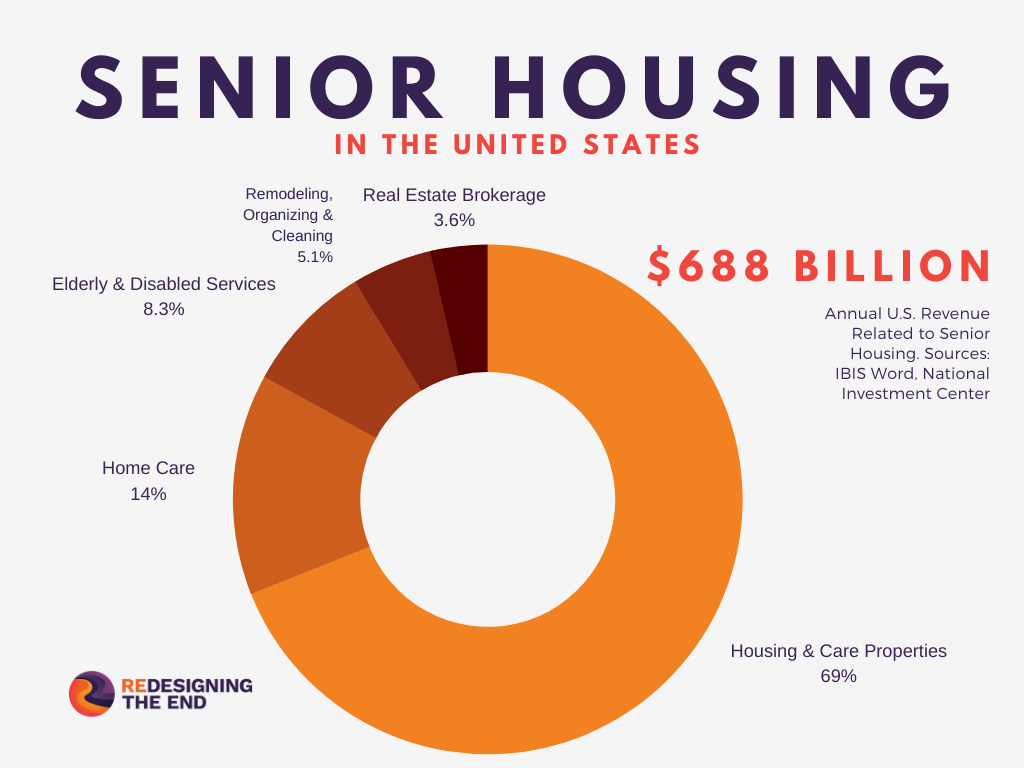Good news! There’s plenty high-quality senior housing available for people with lots of money. Don’t have a lot of money? Well, that’s more complicated and scary.
Americans spend about $688 billion on professional senior housing services. Here’s a breakdown of where that money goes:
Housing & Care Properties – $475 Billion. There are currently about 3.15 million beds at roughly 24,500 senior housing and care properties in the United States.
Home Care – $97 Billion. Home care saves patients billions of dollars every year by treating them in their own homes instead of at hospitals. That figure dramatically undersells the market size because it doesn’t include 37 billion hours of unpaid labor supplied by 40 million non-professional caregivers (a.k.a. family).
Elderly & Disabled Services – $57 Billion. The Elderly and Disabled Services industry provides non-medical care and social assistance services to the elderly and people living with disabilities. Usually this happens in a hospital or medical setting.
Remodeling, Organizing & Cleaning – $35 Billion. Aging in place frequently requires some work to be done in and around the home. This also includes remodeling, repair, organization, and cleaning needed to prepare a house for sale.
Real Estate Brokerage – $25 Billion. Commissions earned through the purchase and sale of residential properties owned by seniors. Some realtors partner with senior housing communities and specialize in this type of transaction.
Silver tsunami, aging baby boomers, blah, blah, blah. It’s no secret that the supply of housing and services must grow to accommodate growing demand. But what parts? How?
High end services are profitable, so rich customers will continue to be served. If anything, there’s excess capacity in that part of the market. That’s not where the problem is. It’s the middle market that is getting squeezed. This is true for a couple of reasons: First, Medicare and Medicaid reimbursements are getting smaller relative to cost increases. Second, there’s a capacity gap due to human capital shortages. The human capital (people) shortage is what I find most interesting. It boils down to two things that are simple but hard:
1. It’s hard to attract and retain good people in hard jobs that don’t pay very much. Home health aides make an average of $24,200 and caregivers in senior care facilities make $37,540. The work is hourly. Turnover is high. Burnout is a problem.
2. There aren’t enough operators with experience managing senior care facilities. “With real estate it’s ‘location, location, location’ but with senior housing it’s ‘management, management, management’” explains JP LoMonaco on the Bridge the Gap podcast. For every experienced management team willing to provide an affordable solution there are a hundred lenders and developers ready to build senior housing units. The bottleneck is a lack of experienced operators to design and run them profitably at affordable prices.
In 2021 we’re going to investigate how companies, governments, and entrepreneurs are addressing these two human capital shortages. We’ll look at business models, technology, training, and policy. How mighty we unlock scalable senior housing solutions for the middle and lower markets?
People my age don’t want to be scared about senior housing. The #1 missing ingredient in senior housing is experienced people. So please – if you’ve got a perspective about why this is true and what solutions we should be featuring, please email me: bhayden @ redesigningtheend.com

